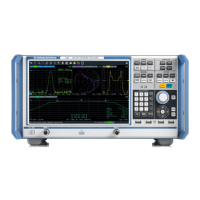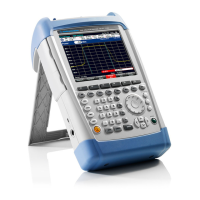Performing configuration tasks
R&S
®
SGS100A
163User Manual 1173.9105.02 ─ 13
Figure 11-2: Example of the test setup
For higher setting/ measuring speeds, use a PCIe switch and PCIe connections.
If a common reference frequency is required, use the internal reference signal of the
signal generator and provide it to the R&S SGS and the connected signal analyzer,
e.g. the R&S FSW.
1. Connect the test equipment as shown on Figure 11-2:
a) Connect the R&S SGS, the R&S SGU and the controller to a LAN switch.
b) Connect the "I/Q OUT" of the base band signal source to the " I/Q IN" of the
R&S SGU.
c) Connect the "I/Q OUT" of the R&S SGS to the I and Q connectors of the R&S
SGS.
d) Connect the "RF 50Ω" of the R&S SGS to the "LO IN" of the R&S SGU.
e) Connect the "TRIG" connectors of the R&S SGS and the R&S SGU.
f) Connect the "RF 50Ω" of the R&S SGU to the RF input connector of the signal
analyzer.
2. Select "SGMA-GUI main panel > R&S SGS > Extension".
Tip: Steps 3 to 5 can be omitted if the R&S SGS and a single R&S SGU are con-
nected using PCIe or USB or by a direct LAN connection. In this case, the R&S
SGS automatically activates the R&S SGU.
3. Press the ID key on the front panel of the R&S SGU (only required if you connect
the components via a company network).
4. In the "Extension" dialog, trigger "Scan".
How to generate I/Q signals

